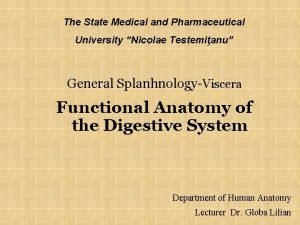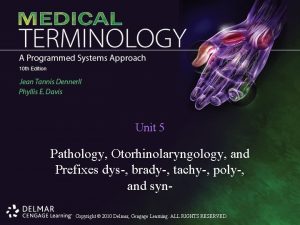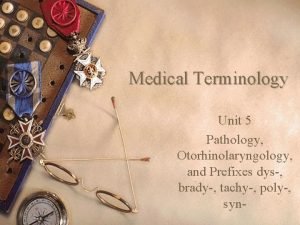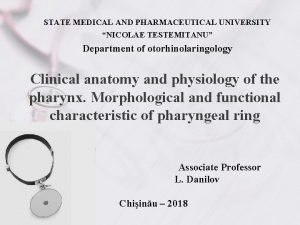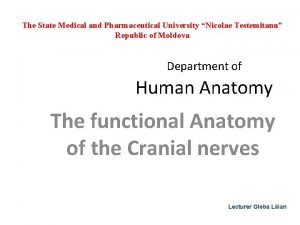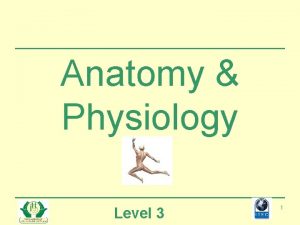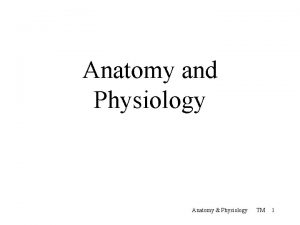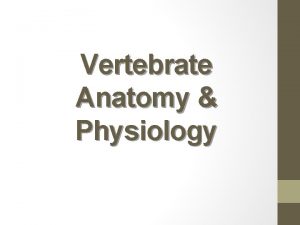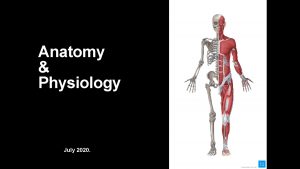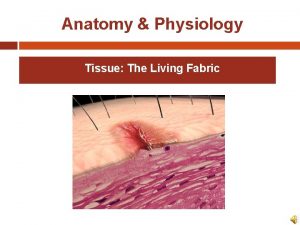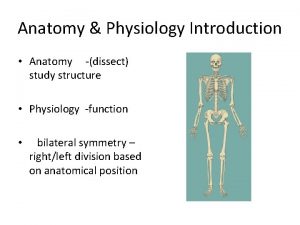SUMPh Nicolae Testemitanu Department Otorhinolaryngology Anatomy and physiology


































- Slides: 34

SUMPh “Nicolae Testemitanu” Department Otorhinolaryngology Anatomy and physiology of the middle ear Associate Professor Diacova Svetlana

Tympanic membrane - TM, membrana tympani, myrinx • Delimits middle and external ear, in sulcus tympanicus in bottom of EAC • In adults TM – a board of ovale shape, translucid, 11 x 9 mm Position: oblique, in new-borns - horizontal. • Layers: 1. extern - skin 2. intern - mucous 3. meddle - fibrous 2 (radial şi circular). • Parts: 1. pars tensa (stretched part) 2. pars flaccida - relaxed, - without fibrous layer (membrana Shrapnelli) 1

Tympanic membrane - TM, membrana tympani, myrinx 3 Color - Gray – Perl Reference points: 1 - hammer handle ; 2 - short apophyses ; 3 - creases – anterior and posterior; 4 - umbo; 5 – light cone. 2 1 5 4

Tympanic membrane - TM, membrana tympani, myrinx Four quadrans: (line along hammer handle through umbo and perpendicular to that): 2 1 anterosuperior 2 posterosuperior 3 anteroinferior 4 posteroinferior 1 4 3

Middle ear Common system of pneumatic cavities : 1. tympanic cavity (cavum tympani); 2. auditory tube (Eustache); 3. antrum and procesus mastoideus

Timpanic cavity (cavum tympani) • Central position • Ventilation through auditory tube and nasofarinx • Communicates with antrum and mastoid cells – through aditus ad antrum • • • Lateral wall– tympanic membrane, Internal wall – labirintic (Promontorium) Anterior wall - tubar (auditory tube), Posterior wall - mastoidic, (aditus ad antrum) Superior wall - tegmen (tegmen tympani), fosa cranii media • Inferioar wall - jugular - (bulbus v. jugularis).

Timpanic cavity (cavum tympani) 3 parts • Superior part – supratympanal (attic or epitympanum). • Middle part - mezotympanum (mesotympanum). • Inferior part – hipotympanum Mucosa – cubic epithelium of one layer 3 ossicles: 1. malleus; 2. incus; 3. stapes. 2 muscles of tympanic cavity: m. Stapedius, m. Tenzor tympani.

Auditory tube (Eustachio) • Communicates with timpanic cavity and nasopharynx • In children: short, large, more horizontal, easy opens, in small children is opened. • Mucosa – voluminous respiratory ciliated epithelium with unique Goblet cells, that produce mucus • Functions: » aeration, » protection » drainage

Mastoidian process Contains pneumatic cells with the biggest cell - antrum. • Communicates with tympanic cavity - through aditus ad antrum. • In newborns – only antrum • Developing – during the first years of life Limits: • Superior - temporalis line, continuation of zygomaticus apophyses. • Anterior –posterior wall of EAC, in postero-super. part - spina suprameatum Henle, antrum’s proiection Antrum – the biggest cell, contains air. Tegmen of antrum delimits from dura mater of the middle cranian fossa 3 types of pneumatization of mastoidian apophyses : pneumatic, diploic, sclerozant.

Mastoidian apophyses • Behind the posterior wall- Sinus lateralis (sinus sigmoideus) – venous sinus of the jugular vein system. • Under inferior wall– bulbus v. jugularis int. • In anterior wall – n. Facialis, EAC • Behind superior wall – middle cranian fossa • Behind middle wall –semicircular canal

Definition. • OTITIS MEDIA (OM) – inflammaion of middle ear (which includes : tympanic cavity, auditory tube (Eustachio), antrum and mastoid cells).

OM HIGH INCIDENCE • 80 - 90 % children – once in a life • 50 - 70 % - 3 and more episodes • 60 - 85 % children by 3 y. o. with bronchitis and pneumonia • 35 - 40 % children of the first 7 years of life with “respiratory infection” • 60 - 70 % children with hipertrophy of palatine amigdals and adenoides

OTITIS MEDIA relations between different forms Acute OM Recurrent OM Chronic Suppurative OM OM with effusion Adhesive OM

OM classification • Acute OM– acute inflammation of middle ear • OM with effusion - presence of liquid behind intact tympanic membrane • Recurrent OM - Recidive of acute OM 3 times in 6 months or 4 times in 12 months

OM classification • Adhesive OM – cicatrization of tympanic cavity , adherences formation • Chronic Suppurative OM - inflamatory chronic purulent procces in middle ear

OM OM with effusion Adhesive OM Lack of diagnostic and an adequate treatment Chronic Supurative OM with risc Of INTRACRANIAL COMPLICATIONS

OME – otitis media with effusion etiologic variabil procces with presence of effusion (exudate, liquid) behind tympanic membrane relativly intact are not caracteristic Acute infection signs: fever, intensive pain

EMO Middle ear containing serous mucous purulent Glue ear OM serous OME Mucous OM sero-mucous OM

OME 1. High Incidence • 60 % children 2. cognitiv –intelectual consequences • speech development retardation • psihoemoţional retardation in child Otologic consequences • Recurrent OM • Adhesive OM • Chronic Suppurative OM • OM with colesteatom with risc of intracranial complications • sensoro-neural hearing loss

OME Etiology • Caused by microbian or viral flora in a small quantity • The most frequent: • Streptococcus pneumoniae • Haemophilus influenzae • Moraxella catarralis

OME Pathogenesis Eustachian tube is opened Microbian toxins or Eustachian tube Alergic antigens = in auditory tube is closed =in tympanic cavity=stimulates „The vacuum”theory, • hiperplazia of epithelium, Is based on a postulat • Goblet cells proliferation , Of nasal obstruction as • paralises ciliar motions, Principal initiative • blocks evacuation moment of exudate from TC Mucous edema, hipersecretion and dereglation of exudate evacuation Leads to auditory tube obstruction.

OME Favorable factors • Early age • malnutrition • Artificial alimentation of a child during first year of life • Genetic anomalies of cranium and face, • Recurrent otitis media during first months • Allergy changes • prematurity • Frequent viral infections

OME Anatomic and functional features in children Auditory tube • shorter • larger • straight • opened Mucosa in nose and tympanic cavity • More irritated by bacteria, viruses, alergens • More easily develop cells, that produce mucous

OME Favorable factors in adults and older children Viral infection Nasal septum deviation sinusitis alergy nazopharingeal tumor proccesses as a complication of a hiperbarooxigenotherapy In pacients of these age groups predominate exudative serous proccesses.

OME In elder children • Hearing loss • Sensation of liquid in the ear • Ear noise Clinical signs In children af early age • iritability • Sleep disturbances • Inadecvate reaction to parents’ calling • Speech development retardation • psiho-emoţional retardation

OME Anamnesis Diagnostics Sleep disturbances Inadecvate reaction to parents’ calling, Speech development retardation Otoscopy TM gray-pink, dull Tragal reflex is not a semnificativ diagnostic sign Pneumootoscopy Impedance Audiometry & Audiometry TM gray-pink, dull, Motional decrease of MT type B of tympanogram Stapedian Reflex absence Conductive hearing loss (30 - 50 d. B)

Otoscopic OME signs NORM

EMO Impedansmetry • type B • Stapedian reflex is absent 0

OM Impedansmetry C A B - 100 mm H 2 O O 0 Types of tympanogram 1. Type A – norm 2. Type B - pathology (OM ? ) 3. Type C - pathologz (auditorz tube disfunction)

OME Audiometry Tonal audiometry • Conductive hearing loss • 10 – 15 % mixt hearing loss Play audiometry • Inadecvate reaction to sounds 30 – 50 d. B on the wholl frequence scale BAER inregistration • inregistration of curve on 35 -40 d. B • prolonged of latency of peak I OAE Inregistration Absence of otoemission to 30 d. B and presence of that to 60 d. B

OME Screening methods • Impedance Audiometry • OAE inregistration • BERA inregistration

OME Treatament methods antibacterial antialergic nasopharyngeal OME, acute General treatment OME, subacute Local treatment

OME Miringotomy

OME Timpanostomy
 Intestine histology
Intestine histology Dys- prefix
Dys- prefix Unit 5 medical terminology
Unit 5 medical terminology Suffix of break
Suffix of break 3 words associated with parts
3 words associated with parts Upper respiratory tract consists of
Upper respiratory tract consists of Tattoo anatomy and physiology
Tattoo anatomy and physiology Anatomy science olympiad
Anatomy science olympiad Specialized stems examples
Specialized stems examples Bone anatomy and physiology
Bone anatomy and physiology Gastric ulcer differential diagnosis
Gastric ulcer differential diagnosis Liver anatomy
Liver anatomy Epigastric region
Epigastric region Difference between anatomy and physiology
Difference between anatomy and physiology Google.com
Google.com The central sulcus divides which two lobes? (figure 14-13)
The central sulcus divides which two lobes? (figure 14-13) 3 layers of muscle
3 layers of muscle Http://anatomy and physiology
Http://anatomy and physiology Waistline
Waistline Physiology of appendix
Physiology of appendix Aohs foundations of anatomy and physiology 1
Aohs foundations of anatomy and physiology 1 Aohs foundations of anatomy and physiology 2
Aohs foundations of anatomy and physiology 2 Anatomical planes
Anatomical planes Anatomy and physiology chapter 8 special senses
Anatomy and physiology chapter 8 special senses Chapter 13 anatomy and physiology of pregnancy
Chapter 13 anatomy and physiology of pregnancy Agriscience unit 26 self evaluation answers
Agriscience unit 26 self evaluation answers Science olympiad forensics cheat sheet
Science olympiad forensics cheat sheet Chapter 2 basic chemistry anatomy and physiology
Chapter 2 basic chemistry anatomy and physiology Contraction
Contraction Anatomy and physiology of pancreas in diabetes
Anatomy and physiology of pancreas in diabetes Anatomy and physiology chapter 7
Anatomy and physiology chapter 7 Anatomy and physiology coloring workbook figure 14-1
Anatomy and physiology coloring workbook figure 14-1 Chapter 10 blood anatomy and physiology
Chapter 10 blood anatomy and physiology Aohs foundations of anatomy and physiology 1
Aohs foundations of anatomy and physiology 1 Aohs foundations of anatomy and physiology 1
Aohs foundations of anatomy and physiology 1
